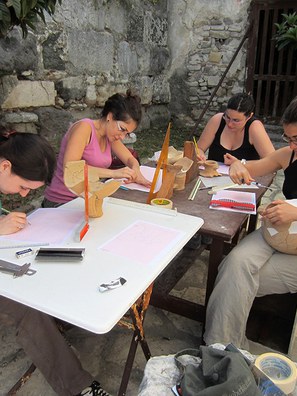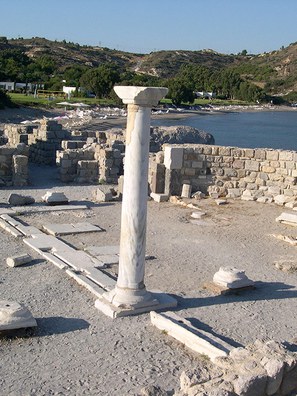The 2013 season of the Italian Archaeological Mission at Kos was carried out between 23 May and 9 June. The team consisted of 21 people: Professor Isabella Baldini and Professor Salvatore Cosentino (University of Bologna), Professor Monica Livadiotti (Polytechnic of Bari), and students trained at various levels in archaeology and history of ancient architecture, including Paolo Baronio, Giulia Bersellini, Stephanie Casadei, Veronica Casali, Silvia Donadei, Francesca Fecoli, Francesca Frasca, Fernando Giannella, Saveria Lo Ioco, Lucia Orlandi, Federica Pannuti, Rita Schiaffino, Francesco Veronesi, and Federico Zoni (graduate students); Giulia Marsili, and Debora Pellacchia (PhD students, archaeologists); and Giuseppe Mazzilli (PhD student, ancient architecture). The 4th Ephorate of Byzantine Antiquities was represented by Dr. Sophia Didioumi.
As in previous seasons, the team was housed at the Hotel Yorgos in Kos. Full cooperation was offered by the local Ephorate (directed by Dr. Maria Michailidou) and by His Eminence Nathaniel, Archbishop of Kos, to whom the various activities of the mission were shown during a very fruitful meeting. In addition to the Dumbarton Oaks Project Grant, the Italian Mission was also funded by the University of Bologna (€3500) and the Italian Ministry of Foreign Affairs (€1500).
After a brief visit to Rhodes by some members of the team, owing to necessary bureaucratic procedures at the Byzantine Ephorate, activity on Kos in 2013 was divided between four tasks:
- Workshop on Koan ceramics of the Byzantine period
- Drawing of the southern basilica of St. Stephanos at Kephalos
- Survey and catalogue of the Byzantine architectural members stored in the Castle of Neratzia
- Survey of the early Byzantine settlements of the island.
Workshop on Koan Ceramics of the Byzantine Period

The workshop, coordinated by Dr. Sophia Didioumi and Mrs. Giulia Marsili, focused on the examination of clay (with the identification of local varieties) and shape, in order to classify different typologies of vessel (local imitations of LR1, LR2, LR3, LR unguentaria). A first stage was devoted to the study of local pottery (common wares, lamps, amphorae) from the excavations carried out by the 4th Ephorate for Byzantine Antiquities in Mastichari and Kephalos (pottery workshops). The last stage concerned the study of imported materials, coming from Syro-Palestinian, Eastern Anatolian, Aegean, and Egyptian contexts. At the end of every step of work, each participant filled out a dossier about each vessel with its drawings. The learning of a method for the classification of Byzantine pottery has been one of the most fruitful results for the students (fig. 1).
Drawing of the Complex of St. Stephanos at Kephalos

The drawing of the south sector of the ecclesiastical complex of St. Stephanos at Kephalos (fig. 2), coordinated by Dr. Giuseppe Mazzilli, was carried out in order to start the plan of the building and to gain an understanding of the structure as a whole. It is a complex of two basilicas, flanking one another along the longitudinal axis and directly connected. The first, larger and located to the south, is preceded by an atrium and a narthex. Work began at the east side of the building moving westward. The whole structure is damaged, and many of its architectural elements are found nearby, while the stones of the higher parts of the walls have been removed for later reuse. Despite its present situation, the building still offers clear evidence for the wealthy monumental nature of the southern basilica and its annexes.
After checking with the total station the plan made by H. Balducci in 1936, a detailed drawing has been made at scale: 1:50. Particular attention has been paid to the presbytery, which preserves on the ground traces of the altar, ciborium, and synthronon, along with their liturgical furniture.
Survey and Catalogue of Byzantine Architectural Pieces Stored in the Castle of Neratzia
A significant part of the activities undertaken in the 2013 season was concerned with organizing a database of the architectural members and inscriptions preserved in the Castle of Kos in two storerooms and also spread on the ground of the castle (figs. 3-4). About 300 objects have been processed and photographed in an attempt to recognize their context of provenance and ensure a rationale for storage and use.

![Fig. 4: Kos, Storeroom in the Castle of Neratzia, grave slab of a Constantine from the basilica of St. Gabriel (Baldini 2013–2014) Fig. 4: Kos, Storeroom in the Castle of Neratzia, grave slab of a Constantine from the basilica of St. Gabriel, 9th–10th c. (from I. Baldini and M. Livadiotti, ed., Architettura protobizantina a Kos: la basilica di S. Gabriele [Bologna, 2011]).](https://www.doaks.org/research/byzantine/project-grants/images/BYZ-PGR_Baldini13-14_fig4.jpg/@@images/61f12a3d-235e-45f5-b8f7-b9432b111dbe.jpeg)
Survey of the Byzantine Settlements and Buildings of the Island
Comprehensive research on early Byzantine settlements has been undertaken in order to collect information about their location, architectural development, and organization. The first step of the work, made by Mrs. Debora Pellacchia, entailed also a collection of bibliography as a preparatory step to the GPS survey, which is expected in 2014. A high number of early Byzantine churches with baptisteries has been detected (“Punta della Sabbia,” St. Paul, Kapamà, Mesarià, Pyli 1 and 2, Kharmili, Linopoti, Liizu 1 and 2, Mastichari, Antimachia, Kardamena 1 and 2, Kampos [Kephalos], Kamila [Kephalos], Kamares, Kephalos 2). Most of these buildings were at the center of a settlement, and this is particularly interesting for the reconstruction of the early ecclesiastical organization of Kos.
The 2013 season of the Italian Archaeological Mission has greatly improved our knowledge of the island and the data available for the reconstruction of its monuments and settlements in Late Antiquity and the early Byzantine period. The team has consistently enlarged the basis of its information and this will have positive repercussions for the progression of the project in 2014. The final writing-up of papers for a volume concerning the early Byzantine city of Kos and its episcopal complex in the Western Baths (archaeological missions undertaken between 2010 and 2012) is also proceeding. This second book devoted to the archaeology and history of Kos (a successor to I. Baldini and M. Livadiotti, ed., Architettura protobizantina a Kos: la basilica di S. Gabriele [Bologna, 2011]) will be published in the winter of 2014 in the series of archaeological monographs of the Department of History, Cultures, and Civilizations of the University of Bologna. The generous financial help provided by DO for the investigations on the island in 2013 will be mentioned and a copy of the book will be sent to its library.